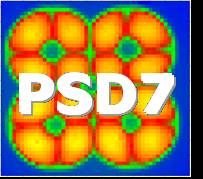Speaker
Prof.
Hiroyuki Takahashi
(School of Engineering, University of Tokyo, JAPAN)
Description
We are developing a new ultra-long multi-grid-type microstrip gas
counters (640 mm long) for neutron scattering experiments at
spallation neutron source facilities. We employed a multi-grid-type
electrode structure for stabilizing the gas amplification process in
this MSGC. Also, we implemented a global-local-grading method for
fast readout method where we divide a cathode signal into two
categories. Positive ions are created around the anode strip and
they travel to the neighboring two cathode strips. In this process
signal charge are divided into two parts. We utilized this nature to
encode the incident position. From one cathode strip a rough
position is obtained and the other cathode strip provides a fine
position. We also implemented a graded cathode pattern. Each cathode
strip is composed of two conductive elements. One element is
connected to the ground and the other one is connected to readout
electronics. Then, we alter the ratio of two conductive areas
according to the incident position. This is implemented by a
periodical electrode pattern in practice. We used a stepwise change
in the rough position. Zig-zag modulation for the fine position. A
test plate was successfully fabricated. X-ray test showed an energy
resolution of ~14% FWHM at 5.9keV. The uniform gas gain was obtained
through entire active length. Position resolution of 1-4 mm FWHM is
obtained and the principle of this method is successfully
demonstrated.
Now we are fabricating another series of plates for a large-are 2-D
array. Each plate has 8 strips with an anode pitch of 3 mm. We plan
to make a tiled 2-D detector with these plates. In this way, we can
fabricate very large micropattern gas detectors at a reasonable cost.
Primary author
Prof.
Hiroyuki Takahashi
(School of Engineering, University of Tokyo, JAPAN)




